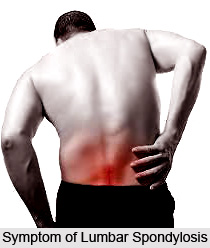 Lumbar spondylosis is the degeneration of the nerves in the lower part of the body that reduces the ability of the involved segment to proceed through its normal range of motion. Compression of the nerves which are within the spinal canal or the nerves that exit the spinal canal leads to pain, numbness or weakness in the legs, buttock or bowel and bladder. In addition to that, abnormalities of gait can also occur. The common symptoms of lumbar spondylosis are recognized to be back pain and stiffness of the lower region of the body. Conversely, lumbar spondylosis is usually termed as asymptomatic, with no particular diagnostic or predictive significance.
Lumbar spondylosis is the degeneration of the nerves in the lower part of the body that reduces the ability of the involved segment to proceed through its normal range of motion. Compression of the nerves which are within the spinal canal or the nerves that exit the spinal canal leads to pain, numbness or weakness in the legs, buttock or bowel and bladder. In addition to that, abnormalities of gait can also occur. The common symptoms of lumbar spondylosis are recognized to be back pain and stiffness of the lower region of the body. Conversely, lumbar spondylosis is usually termed as asymptomatic, with no particular diagnostic or predictive significance.
However, no certain symptom of lumbar spondylosis can be identified as it is usually associated with back or sciatic pains. The disorder is caused in an individual when there is a marked narrowing of the canal over a few segments and when the bone, disk and the ligaments obtrude into it. This condition is termed as lumbar spinal stenosis. The nerve roots of the cauda equina are compressed. When the misalignment of the vertebrae causes stretching of the joint capsules where the vertebrae are adjacent, a pain can occur. Furthermore, the event of backward protrusion of an intervertebral disk is distortion of the local ligaments is a common cause. The emerging nerve root is compressed and thus pain, weakness and numbness in the area are experienced.
Symptom of lumbar spondylosis mainly includes low back pain. Though, low back pain in an individual can be divided into two main types - mechanical type pain and compressive type pain. Mechanical type pain is a result of the injury to the disc, the facet joints, the ligaments or the muscles of the back. Mechanical pain is also caused by disc degeneration. This type of pain starts near the lower spine. Mechanical type pain may also spread towards the buttock and thigh areas and extends below the knee. On the other hand, compressive type pain occurs when the nerve roots that leave the spine are irritated or pinched. Compressive pain can be caused for a herniated disc. The nerves that leave the lower lumbar spine joint to form the Sciatic nerve. This nerve provides sensation and controls the muscles of the lower leg. The foremost signs of compressive pain are associated with the pressure on a nerve root that includes numbness in the area complete by the nerve.
Symptoms of lumbar spondylosis depend on where the spine is affected by spondylosis or spinal osteoarthritis. These symptoms range from mild to severe and may become chronic or even disabling.
The major symptoms include:
•Frequent pain
•Morning low back stiffness
•Pain that decreases with rest or after exercise
•Low back tenderness or numbness
•Sciatica (mild to intense leg pain)
•Weakness, numbness, or tingling in the low back, legs, or feet
•Difficulty in walking
•Bowel or bladder problems
Spondylosis affects both men and women and the lumbar and cervical spines are more frequently affected than the thoracic spine. The curvature of the latter prevents spondylosis from impinging on the spinal cord. Furthermore, lumbar and cervical spondylosis frequently occurs simultaneously in the same individual.




